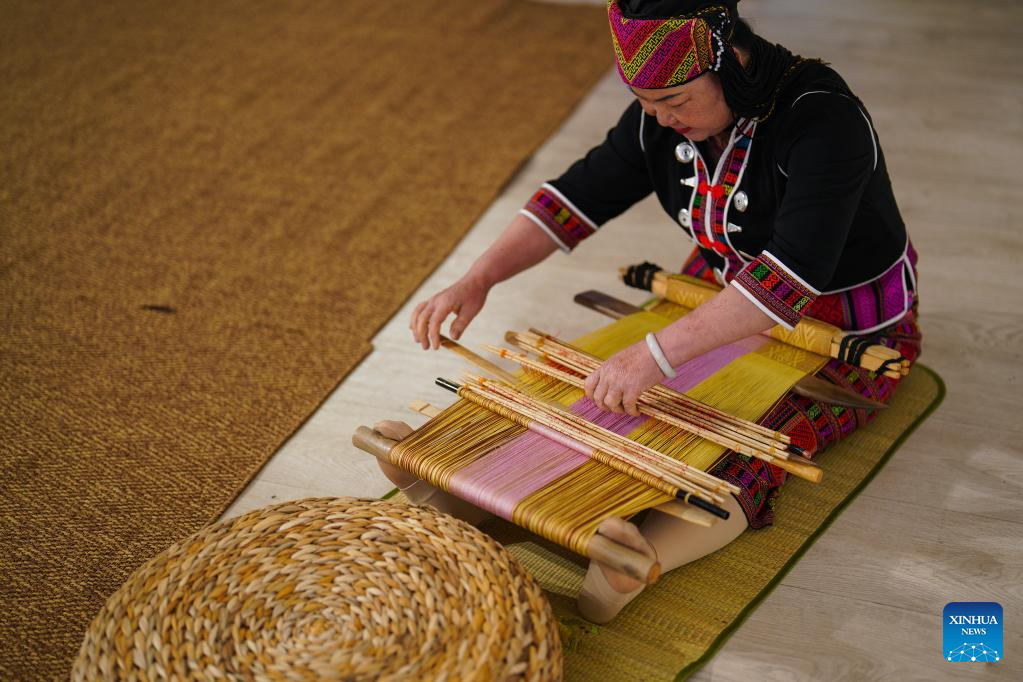Ancient Li brocade tradition sees resurgence in popularity
Li brocade, known as a "living fossil" of China's textile history, has been crafted for centuries by the diligent and talented Li ethnic group in south China's Hainan Province. The custom involves turning natural materials into clothing, weaving their hopes and unique aesthetics into intricate geometric patterns.
In 2009, UNESCO recognized the traditional Li textile techniques of spinning, dyeing, weaving, and embroidering as urgently needing safeguarding, placing them on the List of Intangible Cultural Heritage.
Through continuous innovation and exhibitions, Li brocade has adapted to modernity, gaining recognition for its fashionable, youthful, and internationally acclaimed designs.

Liu Xianglan, a national-level practitioner of the spinning, dyeing and embroidery traditions of the Li people, displays Li brocade weaving techniques during Milan Design Week in Milan, Italy, on April 17, 2023. (Xinhua)
Li brocade recently surged in popularity at a village fashion show in Wuzhishan city in Hainan, drawing more than 40,000 visitors and over 580,000 online views.
Huang Huiqiong, a municipal-level inheritor of traditional Li textile techniques, has been weaving brocade since she was 8 years old, dedicating decades to the craft.
Huang explained that creating a single brocade piece involves four steps: spinning, dyeing, weaving, and embroidering. This process can take three to four months or even longer to complete.
Li brocade is distinct from other silk weaving methods, such as Shu brocade, because it uses locally sourced island cotton or wild hemp, according to Huang.
The weavers use a waist loom and more than 10 different tools, employing techniques like front weaving, back weaving, and double-sided weaving. By manipulating the warp and weft threads, they create pieces that are vibrant and colorful.
Li brocade features over 100 patterns, including depictions of human figures and animals. These designs not only reflect the Li ethnic group's productive activities and folk customs but also represent their aspirations for a better life.
At the village fashion show, Chen Daxu, a municipal-level inheritor of Li textile techniques, proudly displayed the Li brocade items he had collected. He had friends and neighbors model them on the runway, sharing the belief that these treasures should be enjoyed by people rather than stored away.
Chen, a teacher at a local secondary vocational school in Hainan, regularly travels to rural areas to teach. He has visited nearly every Li village in Hainan, finding that these trips are as much about learning as they are about teaching.
"Some endangered techniques can only be found among the elderly in the villages. Once I learn these, I bring them back to the school to teach my students," Chen said.
"As long as we embrace a willingness to learn, the Li brocade techniques will endure," Chen said, emphasizing the crucial role of the younger generation from the Li ethnic group in preserving this ancient cultural heritage.
In Wuzhishan city, there are 22 intangible cultural heritage learning centers, with over 3,500 individuals proficient in Li brocade techniques.
In August 2023, Wuzhishan city partnered with an Italian fashion education institute to offer free training to 30 talented individuals specializing in Li brocade.
Since 2023, Wuzhishan city has sent four groups totaling 69 individuals to participate in heritage fashion and technique exhibitions at Milan Fashion Week in Italy, as well as cultural promotion activities in Singapore and Malaysia, said Wang Yuzhao, deputy director of Wuzhishan City Cultural Center.
Photos
Related Stories
- Inheritor committed to passing on craft of Wuxi fine embroidery in E China's Jiangsu
- Chinese embroidery artist takes ethnic cultural heritages to world
- Company in China's Henan sells wedding embroideries abroad
- Embroidery cooperative dedicated to inheritance of Kirgiz embroidery in NW China's Xinjiang
- Hard-of-hearing embroiderer from NW China's Xinjiang wins global recognition
- Trending in China | Reviving the craft of making hand-embroidered cuju balls
Copyright © 2024 People's Daily Online. All Rights Reserved.









